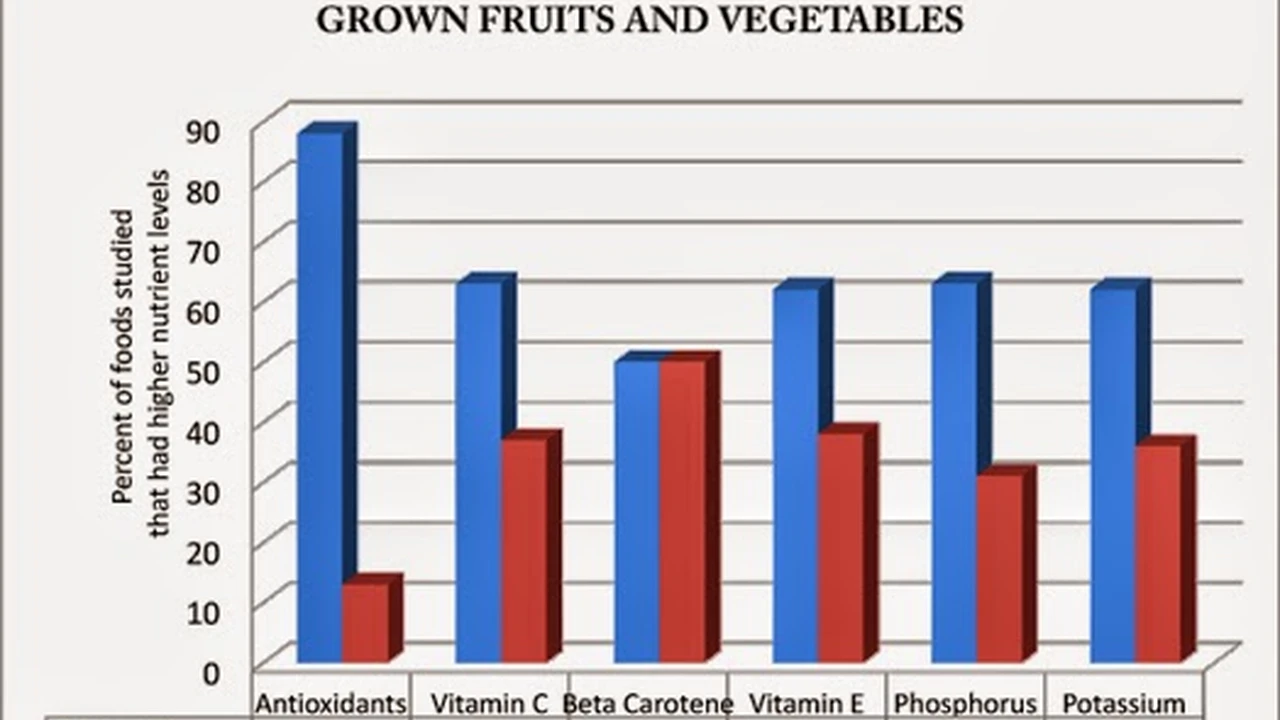Comparing Organic vs Conventional Foods Nutritional Differences
Compare organic vs conventional foods. Explore nutritional differences and decide what's best for your diet.

Comparing Organic vs Conventional Foods Nutritional Differences
Understanding Organic and Conventional Farming Practices
Hey there, health enthusiasts! Let's dive into a topic that's probably crossed your mind more than once while strolling through the grocery store aisles: organic versus conventional foods. It's a debate that's been simmering for years, with passionate arguments on both sides. But what's really the difference, especially when it comes to what ends up on your plate and in your body? We're going to break down the farming practices, the nutritional content, and even touch on the environmental impact, so you can make informed choices that align with your values and health goals.
First off, let's clarify what 'organic' actually means. When you see that USDA Organic seal, it's not just a fancy label. It signifies that the food has been produced according to strict federal guidelines. For crops, this means no synthetic pesticides, herbicides, or fertilizers. Farmers rely on natural methods like crop rotation, composting, and beneficial insects to manage pests and maintain soil fertility. Genetically modified organisms (GMOs) are a big no-no in organic farming. For livestock, organic means animals are raised in living conditions accommodating their natural behaviors, fed 100% organic feed, and are not given antibiotics or growth hormones. It's a holistic approach that aims to promote ecological balance and conserve biodiversity.
On the flip side, conventional farming, while often more efficient in terms of yield and cost, utilizes synthetic inputs. This includes synthetic pesticides to protect crops from insects and diseases, chemical fertilizers to boost growth, and sometimes genetically modified seeds to enhance resistance or yield. In conventional animal agriculture, antibiotics are often used to prevent disease in crowded conditions, and growth hormones can be administered to speed up development. The primary goal of conventional farming is often to maximize production and minimize costs, which has allowed for widespread access to affordable food.
Nutritional Value Organic vs Conventional Produce
Now, for the million-dollar question: is organic food more nutritious? This is where the debate gets really interesting, and sometimes, a little confusing. For years, studies have gone back and forth, with some finding no significant difference and others highlighting key advantages for organic. Let's look at what the science generally suggests.
When it comes to vitamins and minerals, the picture isn't always clear-cut. Some studies have shown slightly higher levels of certain nutrients, like Vitamin C, iron, and magnesium, in organic produce. However, these differences are often small and can be influenced by a myriad of factors, including soil quality, climate, and even the specific variety of plant. It's not as simple as saying 'organic always has more Vitamin C.'
Where organic produce often shines is in its antioxidant content. Antioxidants are those amazing compounds that protect your cells from damage, and several studies have indicated that organic fruits and vegetables tend to have higher levels of these beneficial compounds, such as polyphenols and flavonoids. Why? One theory is that without synthetic pesticides, organic plants have to produce more of their own protective compounds to ward off pests and diseases, which in turn boosts their antioxidant profile.
Another significant difference lies in pesticide residues. Conventional produce often contains detectable levels of pesticide residues, even after washing. While regulatory bodies set limits for these residues, and they are generally considered safe at those levels, some people prefer to minimize their exposure. Organic produce, by definition, has significantly lower or no detectable pesticide residues. This is a major draw for many consumers, especially those with young children or individuals with sensitivities.
Nitrate levels are another point of comparison. Nitrates are compounds found naturally in plants, but high levels can be a concern. Conventional farming, with its use of synthetic nitrogen fertilizers, can sometimes lead to higher nitrate accumulation in certain vegetables. Organic farming practices, which rely on natural nitrogen sources, tend to result in lower nitrate levels in produce.
Organic vs Conventional Meat and Dairy Health Implications
It's not just about fruits and veggies; the organic versus conventional debate extends to meat and dairy products too. Here, the differences can be quite pronounced, particularly concerning antibiotic use, hormone levels, and fatty acid profiles.
One of the biggest distinctions in organic meat and dairy is the absence of antibiotics and growth hormones. In conventional farming, antibiotics are often used preventatively to keep animals healthy in crowded conditions, and growth hormones can be administered to accelerate growth. The concern with conventional practices is the potential contribution to antibiotic resistance in humans and the unknown long-term effects of consuming hormone-treated products. Organic standards prohibit the use of these substances, meaning organic meat and dairy come from animals raised without them.
When it comes to nutritional content, organic milk and meat often boast a more favorable fatty acid profile. Specifically, organic dairy and grass-fed organic meat tend to have higher levels of omega-3 fatty acids and conjugated linoleic acid (CLA). Omega-3s are crucial for heart health, brain function, and reducing inflammation, while CLA has been linked to various health benefits, including anti-cancer properties. This difference is largely attributed to the diet of organic animals, which often includes more pasture grazing and organic feed, leading to a more natural and nutrient-rich composition.
For example, a study published in the British Journal of Nutrition found that organic milk and meat contain around 50% more beneficial omega-3 fatty acids than conventionally produced products. This is a pretty significant difference if you're looking to boost your intake of these essential fats.
Pesticide Residues and Your Health Making Informed Choices
Let's talk more about pesticide residues, as this is often a primary concern for consumers choosing organic. While regulatory bodies like the EPA in the US and similar agencies globally set maximum residue limits (MRLs) for pesticides on conventional produce, the long-term effects of cumulative exposure to multiple pesticides, even at low levels, are still a subject of ongoing research and debate. Some studies suggest potential links between pesticide exposure and various health issues, particularly in vulnerable populations like children.
The Environmental Working Group (EWG) annually publishes its 'Dirty Dozen' and 'Clean Fifteen' lists, which are incredibly helpful resources. The 'Dirty Dozen' highlights produce with the highest pesticide residues, making them good candidates for buying organic if your budget allows. These often include strawberries, spinach, kale, nectarines, apples, and grapes. On the other hand, the 'Clean Fifteen' lists produce with the lowest pesticide residues, meaning you might feel more comfortable buying conventional versions of these, such as avocados, sweet corn, pineapples, onions, and papayas.
Making informed choices doesn't necessarily mean going 100% organic all the time. For many, it's about prioritizing. If you're concerned about pesticide exposure, focusing your organic purchases on the 'Dirty Dozen' items can be a practical and impactful strategy. For other items, conventional might be perfectly fine, especially if you wash them thoroughly.
Environmental Impact Organic vs Conventional Farming
Beyond personal health, the choice between organic and conventional also has significant implications for our planet. Organic farming is often lauded for its environmental benefits, and for good reason.
One of the biggest advantages of organic farming is its positive impact on soil health. By avoiding synthetic fertilizers and pesticides and relying on practices like crop rotation, cover cropping, and composting, organic methods build healthier, more fertile soil. Healthy soil is better at retaining water, preventing erosion, and sequestering carbon, which is crucial for combating climate change. It also supports a thriving ecosystem of microorganisms, which are vital for nutrient cycling.
Biodiversity is another area where organic farming shines. The absence of synthetic pesticides and herbicides means a more hospitable environment for beneficial insects, pollinators (like bees!), birds, and other wildlife. This contributes to a more balanced ecosystem and can help protect endangered species. Conventional farming, with its reliance on broad-spectrum chemicals, can harm non-target species and reduce biodiversity.
Water quality is also a major concern. Runoff from conventional farms can carry synthetic pesticides and fertilizers into waterways, leading to pollution, algal blooms, and harm to aquatic life. Organic farming practices, with their reduced use of synthetic chemicals and improved soil health, tend to minimize this type of pollution, protecting our precious water resources.
However, it's not a completely one-sided story. Conventional farming often boasts higher yields per acre, meaning it can produce more food on less land. This can be seen as an environmental benefit in itself, as it reduces the need to convert natural habitats into farmland. The energy footprint of organic farming can also be debated; while it uses less energy for synthetic fertilizer production, some organic practices might require more land or labor, which can have its own energy implications. The key is that both systems have their trade-offs, and continuous innovation in both organic and conventional agriculture is essential for sustainable food production.
Cost and Accessibility Navigating Your Grocery Budget
Let's be real: one of the biggest factors influencing our food choices is often cost. Organic foods typically come with a higher price tag than their conventional counterparts, and this can be a significant barrier for many households. But why is organic more expensive?
Several factors contribute to the higher cost of organic production. Organic farming methods are often more labor-intensive, as farmers rely on manual weeding and natural pest control rather than chemical shortcuts. The certification process itself can be costly and time-consuming for farmers. Organic yields can sometimes be lower than conventional yields, especially during the transition period, meaning farmers have less product to sell. Additionally, the supply chain for organic products can be smaller and less efficient, leading to higher distribution costs. All these factors add up, and the consumer ultimately bears the cost.
So, how can you navigate this if you're on a budget but still want to incorporate more organic foods into your diet? Here are a few tips:
- Prioritize with the 'Dirty Dozen': As mentioned earlier, focus your organic purchases on the fruits and vegetables that tend to have the highest pesticide residues.
- Buy in Season: Produce that's in season is generally more affordable, whether it's organic or conventional. Check out local farmers' markets for potentially better deals on organic produce.
- Frozen Organic Options: Frozen organic fruits and vegetables can often be more cost-effective than fresh, especially for items like berries or spinach. They're picked at their peak ripeness and flash-frozen, locking in nutrients.
- Shop Store Brands: Many grocery stores now offer their own organic lines, which can be cheaper than national organic brands.
- Consider Bulk Buying: For pantry staples like organic grains, beans, or nuts, buying in bulk can significantly reduce the per-unit cost.
- Grow Your Own: If you have a garden, even a small one, growing your own organic produce is the most cost-effective way to get fresh, pesticide-free food.
Specific Product Recommendations and Comparisons for Organic Choices
Alright, let's get down to some specific product recommendations and comparisons to help you make those organic choices in the supermarket. This isn't an exhaustive list, but it covers some popular categories where organic options are readily available and often make a noticeable difference.
Organic Dairy Products Milk Yogurt Cheese
When it comes to dairy, the organic difference is often about what the cows eat and how they're treated. Organic milk, yogurt, and cheese come from cows that haven't been treated with antibiotics or growth hormones and have access to pasture. This often translates to a better fatty acid profile, as discussed earlier.
- Organic Valley Whole Milk: A widely available and trusted brand. Their milk is known for its rich flavor and commitment to pasture-raised cows. Price: Around $4-6 per half-gallon.
- Stonyfield Organic Greek Yogurt: Offers a good range of flavors and plain options. Their yogurts are made with milk from pasture-raised cows and contain live active cultures. Price: Around $1.50-2.50 per single-serve cup.
- Horizon Organic Cheese Sticks: Great for snacks, especially for kids. Made from organic milk, these are a convenient way to get organic dairy. Price: Around $5-7 for a pack of 12.
Comparison: Conventional dairy is typically cheaper (e.g., store-brand milk for $2-3 per half-gallon). The main trade-off is the potential presence of hormones and antibiotics, and a less favorable omega-3 to omega-6 ratio. For those concerned about these factors, organic dairy is a clear winner.
Organic Produce The Dirty Dozen and Clean Fifteen
This is where the EWG's lists come in super handy. Prioritizing organic for the 'Dirty Dozen' can significantly reduce your pesticide exposure.
- Organic Strawberries (Dirty Dozen): Conventional strawberries are consistently at the top of the 'Dirty Dozen' due to high pesticide residues. Opting for organic here is a strong recommendation. Brands like Driscoll's Organic or store-brand organic are good choices. Price: Can be $4-7 per pound, depending on season.
- Organic Spinach/Kale (Dirty Dozen): Leafy greens are another high-residue category. Organic options from brands like Earthbound Farm or your local organic farmer are excellent. Price: Around $3-5 per 5oz bag.
- Conventional Avocados (Clean Fifteen): Avocados have thick skins, meaning pesticide penetration is minimal. Buying conventional here is a good way to save money without much compromise. Price: Around $1.50-2.50 each.
- Conventional Onions (Clean Fifteen): Similar to avocados, onions are generally low in pesticide residues. Price: Around $1-2 per pound.
Comparison: The price difference for 'Dirty Dozen' items can be substantial (e.g., conventional strawberries might be $2-4 per pound). For 'Clean Fifteen' items, the price difference is less impactful, making conventional a more budget-friendly choice without significant health concerns regarding pesticides.
Organic Meat and Poultry Grass Fed Options
Organic meat and poultry mean no antibiotics, no added hormones, and organic feed. Grass-fed organic beef takes it a step further, ensuring the animals primarily graze on pasture, which further enhances the omega-3 content.
- Applegate Organics Grass-Fed Beef: A popular choice for organic and grass-fed beef. Their ground beef is great for burgers or tacos. Price: Around $8-10 per pound.
- Perdue Harvestland Organic Chicken Breast: Widely available and a good option for organic chicken. Price: Around $7-10 per pound.
- ButcherBox (Subscription Service): If you're serious about high-quality organic and grass-fed meats, a subscription service like ButcherBox delivers directly to your door, often at a better per-pound price than retail for premium cuts. Price: Varies by box size, typically $120-169 per month.
Comparison: Conventional meat and poultry are significantly cheaper (e.g., conventional ground beef for $4-6 per pound, conventional chicken breast for $3-5 per pound). The trade-off is the potential for antibiotic residues, added hormones, and a less favorable fatty acid profile. For those prioritizing animal welfare and specific nutritional benefits, organic and grass-fed options are worth the investment.
Organic Pantry Staples Grains Legumes Oils
For pantry items, the organic benefit often comes down to avoiding GMOs and certain processing chemicals, as well as ensuring the absence of synthetic pesticides in the growing process.
- Bob's Red Mill Organic Rolled Oats: A staple for breakfast. Organic oats ensure no glyphosate (a common herbicide) residues. Price: Around $5-7 for a 32oz bag.
- Eden Organic Black Beans: Canned organic beans are convenient and ensure no synthetic pesticides were used in their cultivation. Price: Around $2-3 per can.
- Kirkland Signature Organic Extra Virgin Olive Oil (Costco): A great value for organic EVOO, perfect for cooking and dressings. Price: Around $15-20 for a 2-liter bottle.
Comparison: Conventional pantry staples are generally much cheaper (e.g., conventional oats for $3-4 per 42oz, conventional canned beans for $1-1.50 per can). For items like grains and legumes, the organic choice primarily addresses concerns about pesticide residues and GMOs. For oils, organic ensures the source material was grown without synthetic chemicals.
Making the Best Choices for Your Health and Budget
So, after all this, what's the takeaway? The choice between organic and conventional foods isn't always black and white, and it certainly doesn't have to be an all-or-nothing decision. Both systems have their merits and drawbacks, and what's 'best' often depends on your individual priorities, health concerns, and budget.
If you're concerned about pesticide exposure, prioritizing organic for the 'Dirty Dozen' fruits and vegetables is a smart move. If you're looking to boost your omega-3 intake and avoid antibiotics and hormones, organic and grass-fed meat and dairy are excellent choices. For pantry staples, organic can offer peace of mind regarding GMOs and chemical residues.
Remember, the most important thing is to eat a diet rich in whole, unprocessed foods, regardless of whether they're organic or conventional. Focus on plenty of fruits, vegetables, lean proteins, and healthy fats. Wash your produce thoroughly, whether it's organic or conventional, to remove dirt and surface residues.
Ultimately, the goal is to make informed decisions that support your health, your family's well-being, and the planet. Don't let the perfect be the enemy of the good. Every step you take towards healthier eating, whether it's choosing organic when you can or simply incorporating more fresh produce, is a win. Happy eating!
:max_bytes(150000):strip_icc()/277019-baked-pork-chops-with-cream-of-mushroom-soup-DDMFS-beauty-4x3-BG-7505-5762b731cf30447d9cbbbbbf387beafa.jpg)






